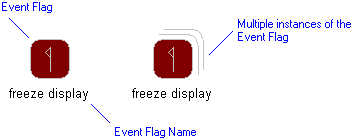Event flag (dictionary item)

For automation interface information about an Event Flag, click here
Event flag (automation interface).
An Event Flag indicates that a given event has happened. It is used when tasks need to communicate but not necessarily synchronize. The standard operations associated with an event flag group are:
• Set
• Clear
• Read
You can create an Event Flag through the context menu of a Package: right-click the Package, and select > > > . In addition, you can create an Event Flag through a Concurrency Diagram.
When used on a diagram, an Event Flag's notation is as follows:

The following sections provide information about how an Event Flag is used in the model. For more information about a property, item, model part or diagram, click it.
Properties
In addition to the
standard properties, an Event Flag has these properties:
The Class box on the Options tab of a Event Flag's Property Pages shows the Class, Data Type or Interface that owns the Operations that implement the Event Flag. |
Owned by
Owns
 Dependency — The Dependency is owned jointly by the Event Flag and the other associated item. The access permissions you have to a Dependency are determined by the access permissions of the dependent item.
Dependency — The Dependency is owned jointly by the Event Flag and the other associated item. The access permissions you have to a Dependency are determined by the access permissions of the dependent item.Defined in these parts of the model
Shown on these diagrams
Can be linked to these dictionary items
 on the Event Flag's icon indicates that the item is a
on the Event Flag's icon indicates that the item is a
 Model
Model Package
Package Comment
Comment Constraint
Constraint Concurrency Model
Concurrency Model Concurrency Diagram
Concurrency Diagram Variant Diagram
Variant Diagram Class
Class Data Type
Data Type Interface
Interface Stereotype
Stereotype